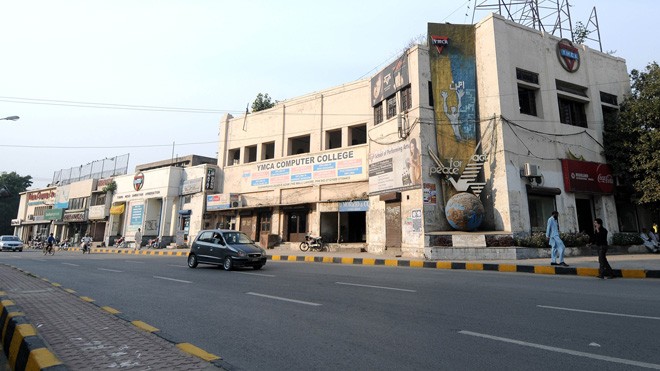
Not many people would remember the many cafés and restaurants that defined the Mall Road of yesteryears

One pleasant summer afternoon, I and my artist friend M. Shareef were driving down the Mall Road, from the Post Master General Office, looking for a peaceful spot -- a café or tea house -- where we could sit down and discuss the plot of a TV play.
There were hotels and motels to be seen. But we couldn’t find a suitable place, the kind we once had.
My mind went nostalgically down memory lane and I was reminded how, in days past, we had a number of coffee and tea houses dotting the Mall. They offered a happy ambience and reasonable rates.
These places were also known by their customers -- eminent writers, poets, artists, singers, broadcasters, journalists and educationists of the time, who would have discussions over cups of tea or coffee for hours on end. They were ‘regulars,’ so to say. If you wanted to meet any of them, you knew where to catch them.
Cheney’s Lunch Home was one such iconic place. Located close to Anarkali Chowk, the restaurant was a famous meeting point of poets and writers.
Cheney’s also attracted artists from Radio Pakistan, Lahore, and ghazal as well as classical singers who would be seen bonding with each other on puffs of cigarettes and hot cuppas. Sadly, the place does not exist any more.
Next to it, the historical Pak Tea House -- set up in pre-partition times as India Tea House -- has always been a favourite joint for thinkers, writers, journalists et al. It is said to have played an integral part in post-Independence Urdu literature.
This is the only tea house of yore which has survived; though, it saw a temporary closure when an attempt was made to convert it into a tyre shop.
Now renovated, portraits of literary luminaries stare down from the walls of the tea house; they were the people who would frequent the place, read out their verses, essays, short stories etc., and hold seminars and book-launching events.
Facing Pak Tea House was a small coffee bar called Peju. It was usually visited by the staff of banks and government offices in the vicinity. This tiny, 15-seat café has long been shut down.
And so has the YMCA Restaurant, a smallish facility inside the YMCA building where people from nearby offices and educational institutions would flock together.
In the Dyal Singh Mansion building, a branch of the famous Shezan restaurant would traditionally serve lunch and dinner aside from tea, coffee and snacks. The place had come to be known for its customers that ranged from political workers lawyers and business men. Soon it stopped serving tea, and was eventually burnt down by protestors.
Capri and Kabana were two cafés, situated next to each other in Tollington Market, opposite Punjab University’s old campus, where the students from different educational institutions, especially the boarders, would famously pour in. They would mingle and enjoy snacks in a lively atmosphere.
Capri was one of the pioneer restaurants in serving Chinese cuisine in Lahore. Kabana was known to be a centre of foreign students especially those from Iran and Palestine. They would feel at home here and also enjoy food.
The customers of both these snack bars were said to be quite friendly with the waiters who had served for a long time.
Right across the Dyal Singh Mansion, there was a restaurant named Salateen. It offered popular Karachi and Delhi food items. It could not be a success and was bought by another party that renamed it as 786 and, later, wound up their business.
A restaurant named Shiraz, situated off Regal Cinema, met a similar fate. However, in its heyday, the place was known for its karrak (strong) tea and spicy food.
Shezan had another branch opposite Masjid-e-Shuhada, which was famous for its tea, coffee and bakery items. I liked visiting the place with my university fellows. It was closed for reasons not known.
Carry Home is one olden place which has survived. Serving since 1947 on Beadon Road, the restaurant is famous for its delicious meals and tea.
Shalimar Restaurant was situated inside the Shalimar Departmental Store, which was very popular among the young people who would come to the place for shopping and also have a short tea break. This has also been shut down.
Indus Hotel Restaurant stood out among a bevy of restaurants on the Mall for their high-profile visitors such as Z.A. Bhutto who liked to hold press conferences and party meetings there. Bhutto would often stay at Indus when visiting Lahore.
Going further down the Mall Rd, Mansy Restaurant at Shah Din Building, Charing Cross, was a great attraction for employees of banks and offices in the adjoining areas. This too was wrapped up to make way for a bank branch.
Salloos Restaurant, in the basement of the Wapda House, was popular with sportspeople, business men and senior artistes. A part of the restaurant was dedicated to a tea/coffee bar and the other for fine dining.
Salloos enjoyed a great buzz. But this one, too, was shut down for the owners’ more commercial goals.
Sadly, today, no one remembers these cafés and restaurants that defined the Mall Road. They are history now.